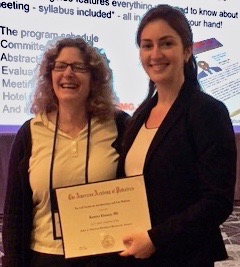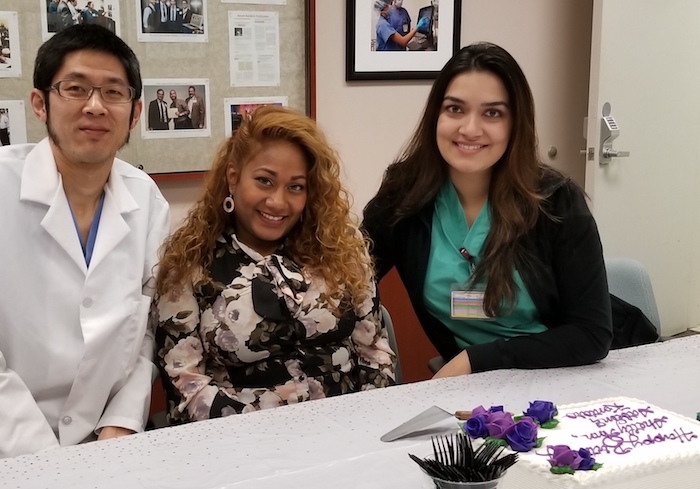
| Volume 29 Number 4 | Stony Brook, NY | < April 2018 > |
 |

|
| Dr. Abola | April Calendar | Visiting Professor | STARS |
| Meeting Report | CA-3 Resident Spotlight! | Family News | New Publications |
| Synaptic Communication | Where is That? | Monthly Muscle Chillaxant |
|
Dr. Ramon Abola Promoted to Clinical Associate Professor
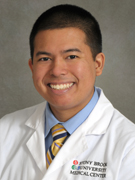
Congratulations to Dr. Ramon Abola on being promoted to Clinical Associate Professor of Anesthesiology! Dr. Abola joined our Attending staff in 2010 following his graduation from our Residency Program. He is a member of both the Acute Pain and Obstetric Anesthesia Divisions. His service to the University includes membership in the Departmental Quality Assurance Committee, the Quality Assurance SubCommittee of the Department of Ob/Gyn, and the Labor and Delivery – Safe Motherhood Initiative Committee for Maternal Hemorrhage Committee. He has a grant from Merck to study "Pulmonary Function, muscle strength, time to extubation, and quality of recovery in the post anesthesia care unit after reversal of neuromuscular blockade with neostigmine or sugammadex." Recently, Ramon has been very active in the Perioperative Quality Improvement Group which has been working with The American Society for Enhanced Recovery (ASER) to develop consensus statements regarding Enhanced Recovery Pathways. In the past few months, the Group has published three such Consensus Statements and Ramon is the first author of one of these. Best wishes, Ramon, on your well-deserved promotion! 
|
|
April Calendar

Pansies are not the flower of April. I like them anyway! Wed. Apr 4. Dr. TJ Gan will chair the Faculty Meeting at 7:00 am in Lecture Hall 5. Fri. Apr 6. Deadline for submitting abstracts to Academic Research Evening. Email to AnesResearchEvening@stonybrookmedicine.edu Tue. Apr 10. Visiting Professor Dr. Jean-Francois Pittet will speak to the residents on "Nosocomial Pneumonia and Amyloid Disease" at 5:00 pm in the Anesthesia Library. Wed. Apr 11. Visiting Professor Dr. Jean-Francois Pittet will speak to the department on "Blood Transfusions, Coagulation Abnormalities and Severe Trauma" at 7:00 am in Lecture Hall 5. Tue. Apr 17. Dr. Jun Lin will talk about his research on "Sevoflurane vs propofol on metastasis of breast cancers in mouse models" at 4:00 pm in the Family, Population & Preventive Medicine Seminar Room (066) on Level 3. Wed. Apr 18. Dr. Anupam Sharma will present his Senior Grand Rounds at 7:00 am in Lecture Hall 5. Wed. Apr 25. Dr. Rishimani Adsumelli will conduct the departmental Quality Assurance meeting at 7:00 am in Lecture Hall 5. 
|
|
Visiting Professor - Dr. Jean-Francois Pittet
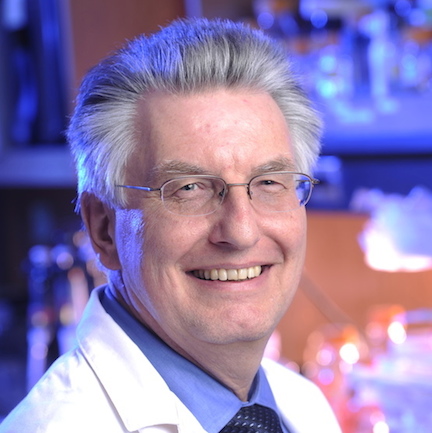
Photo credit Our Visiting Professor for April is Dr. Jean-Francois Pittet, David Hill Chestnut Endowed Professor in the Department of Anesthesia and Perioperative Medicine at the University of Alabama, Birmingham. Dr. Pittet received his MD from the University of Lausanne, Lausanne, Switzerland and stayed there for the first year of his residency in anesthesiology. He then moved to Kantonsspital St. Gallen to complete the residency and for a Fellowship in Critical Care Medicine. This was followed by a Research Fellowship in Experimental Surgery, University of Geneva. He then moved to the US to do a Research Fellowship at the Cardiovascular Research Institute, University of California-San Francisco. Dr. Pittet remained at UCSF Department of Anesthesiology from 1992 to 2010 going through the ranks from Assistant Professor to Professor. During this time, he was also an Investigator at UCSF's Cardiovascular Research Institute and was the Director of the department's T32 Training Grant. In 2010, Dr. Pittet moved to the University of Alabama at Birmingham as Professor, Vice Chair of the Department of Anesthesiology and Director of the Division of Critical Care Medicine. In 2013, he was named David H. Chestnut Professor of Anesthesiology. Throughout his career, he has maintained his position as Privat-docent in Geneva. Dr. Pittet has an outstanding record of service to professional publications. He was on the Editorial Boards of American Journal of Respiratory and Critical Care Medicine and American Journal of Physiology (Lung). He served as an Associate Editor for Anesthesiology in 2013 and as Editor of that journal in 2014. Two years ago, Dr. Pittet was appointed Editor-in-Chief of Anesthesia and Analgesia. Dr. Pittet's research interests are Critical Care Medicine, Perioperative Medicine. He has over 200 peer-reviewed original research publications spanning Basic Science and Clinical Research. In addition, he has authored nearly 50 review articles and 20 book chapters. He has garnered grant support from the NIH and other agencies either as PI or Co-Investigator since the 1990s. Currently, his research is supported by the Department of Defense for two projects: Glycocalyx Mechanoregulation of Angiopoietin-2 and Post-Traumatic Lung Injury and Therapeutic Recovery of Immune and Lung Tissue Bioenergetic Homeostasis in Sepsis- Induced Immunosuppression. Dr. Pittet has trained over 30 MD and MD/PhD students throughout his career. We are honored to have Dr. Pittet visit us at Stony Brook! On Tuesday, April 10, Dr. Pittet will speak to the residents on "Nosocomial Pneumonia and Amyloid Disease". The following morning, he will present to the department at Grand Rounds; his talk is entitled "Blood Transfusions, Coagulation Abnormalities and Severe". 
|
|
Family News
Dr. Jonathan Bacon and his wife Nicol welcomed Everleigh Enora Bacon! Everleigh, was born at 9:56 pm on March 17; 6 lbs 6 oz and 19 inches. Welcome! 
|
|
New Publications
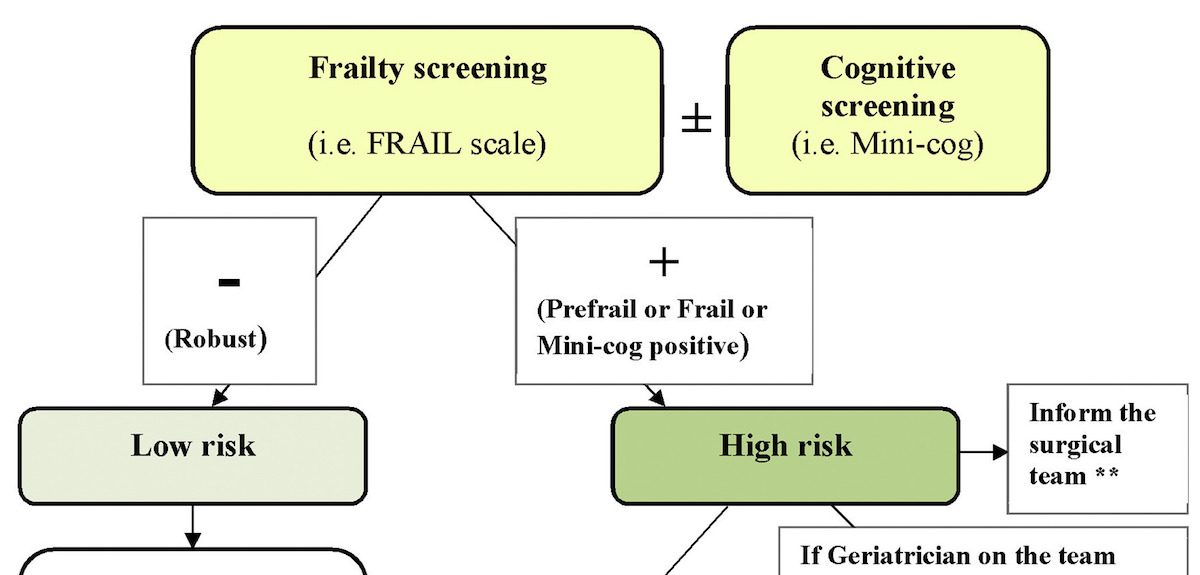

|
|
Synaptic Communication
James P. Dilger, PhDIn the February 2018 issue of SleepTalker, I wrote about Sarah Adamo, the high school student who worked in my lab last summer. Sarah participated in the New York State Science and Engineering Fair (NYSSEF) on March 19. I am delighted to report that she placed first in the Animal Science category! Moreover, her presentation was cited as "Best in Fair"! Sarah will move on to ISEF (International Science and Engineering Fair) which takes place in Pittsburgh, May 13-18. Bravo Sarah!! 
|
|
Where on Campus is That?
James P. Dilger, PhD

|
|
SleepTalker, the Stony Brook Anesthesiology Newsletter is published by the Department of Anesthesiology
Stony Brook Medicine, Stony Brook, NY Tong Joo Gan, M.D., M.H.S., F.R.C.A., M.B.A., Chairman Editorial Board: James P. Dilger, Ph.D.; Stephen A. Vitkun, M.D., M.B.A., Ph.D.; Marisa Barone-Citrano, M.A.; Richard Tenure, M.D. |






